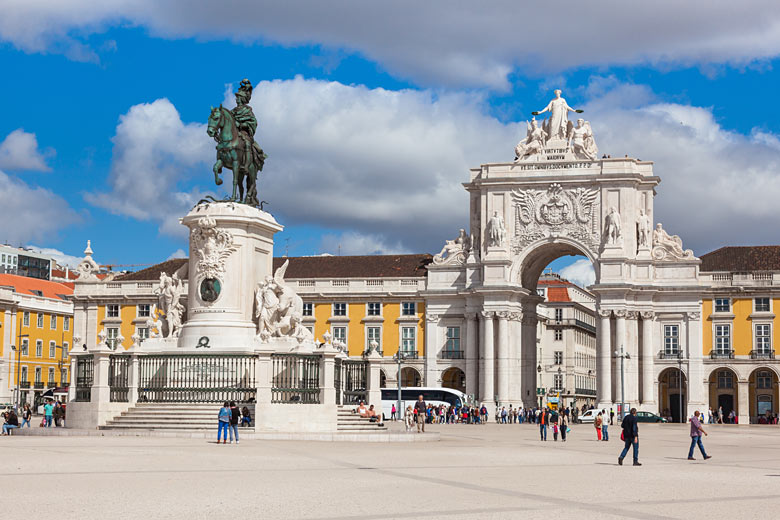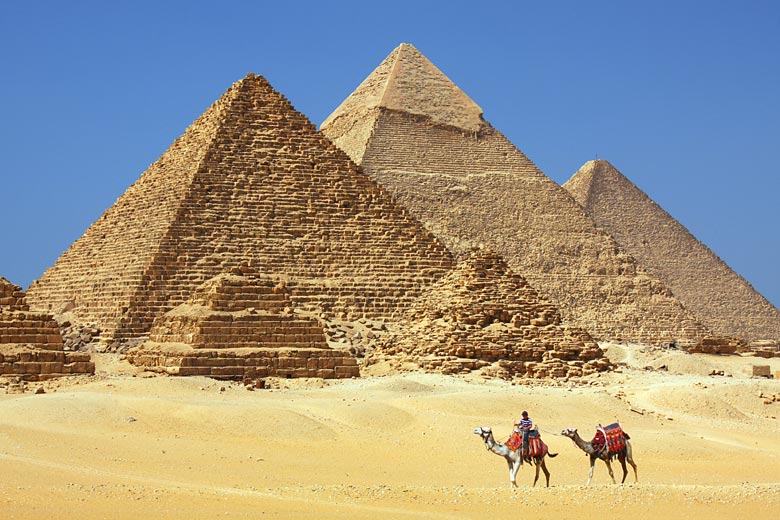16 fabulous things you might not know about Seville
One sip of Seville* and you'll likely be hooked. This sumptuous city is a siren calling from the warm climes of southern Spain that beguiles all who come to learn about its past and experience its present.
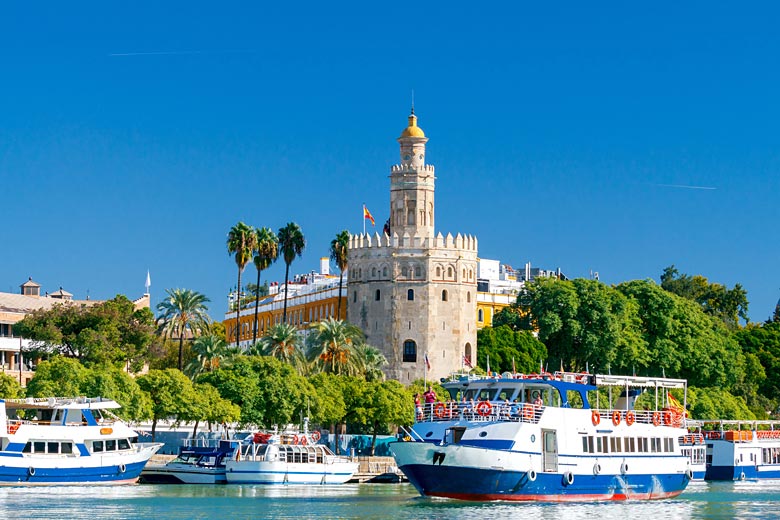
Its role as a major player in shaping Spain* is a huge part of its appeal. It hosted Roman and Moorish invaders, and the latter's 800 years of rule have left its mark on everything from the culture and cuisine to the architecture.
As well as a stronghold of the Spanish Inquisition it was also the heartland of Spain's Golden Age of Discovery with voyages departing for the New World from its port while wealth, trade and influence flowed right back in.
Nowadays, it hums with the easy-going life of those who're lucky enough to live under perpetual sunshine. The parks, tapas bars and endless schedule of fiestas all create a sense of a city that's as archetypally Spanish as you can get.
Here, we look at some of the fascinating things you might not know about Seville but could very well be tempted to see for yourself on your next city break.
Getting to Seville: browse the latest online savings on holidays with First Choice*.
1. It's the capital of Andalucía
Andalucía, the southernmost region of mainland Spain, typically drenched in sunshine and striped with olive groves and sunflowers, is the country's second-largest and, arguably, most popular.
Home to major destinations like Málaga, Córdoba, Granada and Cádiz, it's Seville, the fourth-largest city in Spain, that takes the top spot as the region's capital.
2. It has the world's largest Gothic cathedral
Seville's Catedral de Santa María de la Sede, or Cathedral of Saint Mary of the See, is the largest Gothic cathedral in the world.
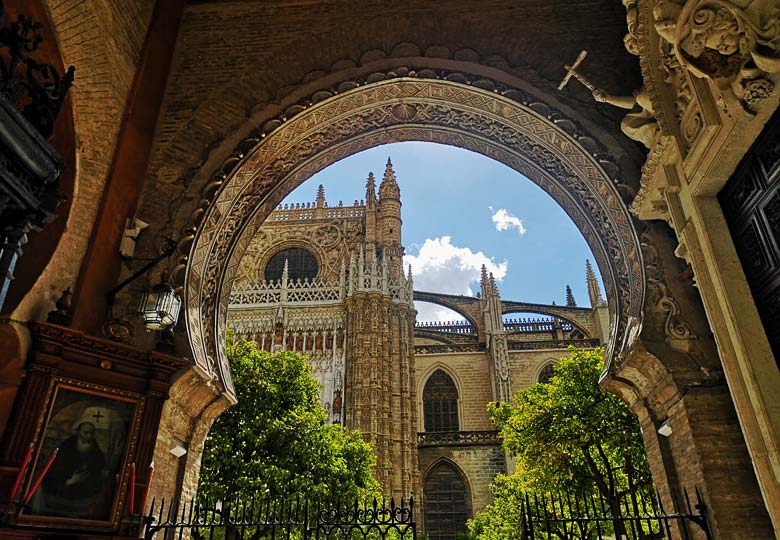
If we roll back the centuries, we see that the present structure dates from the 15th century, although an earlier cathedral was constructed on the site of a former 12th-century Almohad mosque. It also has the longest nave of any cathedral in Spain.
3. Christopher Columbus is buried there
Inside the cathedral, an elaborate tomb marks the final resting place of Christopher Columbus.
Columbus died in the northern Spanish city of Valladolid in 1506 and his remains were buried and moved numerous times over the following centuries. After a brief stint in Seville and what is now the Dominican Republic, his final wish was granted when he was buried in Havana.
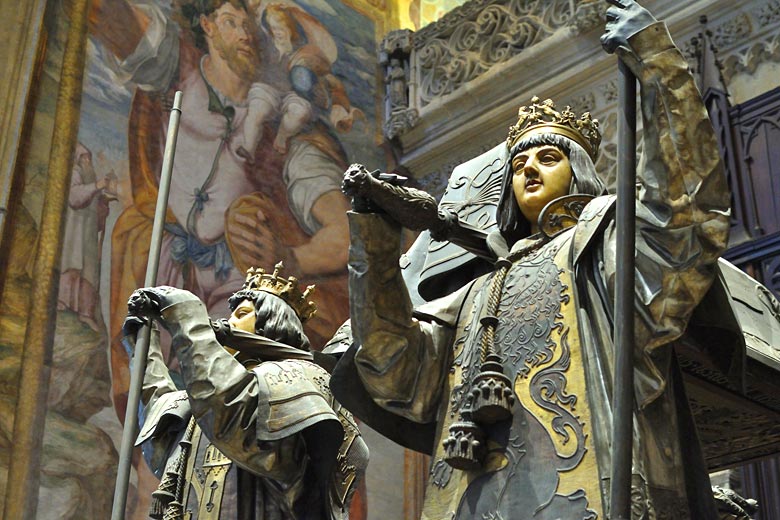
However, following the Spanish-American War of 1898, which led to Cuba's independence, at least some of Columbus's remains were transferred back to Spain and reburied within Seville's cathedral in 1899.
4. There are three UNESCO sites
Seville has three UNESCO World Heritage sites, all within close proximity of each other. Along with the cathedral, there's the Alcázar and the Archivo General de Indias.
Dating in parts from the Moors in the 10th century, the Alcázar was built as a palace for the then Muslim governor. Although rebuilt various times over the centuries and moved from Muslim to Christian hands, its purpose as an official residence remains the same to this day.
Prepare to spend a few hours within the courtyards clad in bold geometric tiles and meandering through the vast gardens, which include an array of flowers, plants and palms. Go early to avoid the crowds and find a shady spot with a soundtrack of trickling water for a brief siesta.

Meanwhile, the Archivo General de Indias, a shining example of Spanish Renaissance architecture, dates from the late 16th century. As the general archive of the Indies, it has amassed one of the most comprehensive collections of contemporary sources and documents relating to the discovery of the New World anywhere.
Together, the three sites showcase the finest examples of Islamic and Christian architecture as well as the might of Spain during the Golden Age of Discovery.
5. Spain's busiest river runs through it
The Guadalquivir River is the lifeblood of Seville, not to mention Spain's busiest river in terms of traffic as it's the only major river that can be navigated by larger vessels.
Although its source is more than 300 km to the northeast in the Sierra de Cazorla, it's currently only navigable from Seville out into the Gulf of Cádiz.
In fact, the first voyage to circumnavigate the globe, the Magellan-Elcano Expedition, set sail down the Guadalquivir River from Seville in 1519. Today, its port remains a busy one welcoming cargo and cruise ships.
6. Seville oranges grow on trees
This is where you'll find juicy Seville oranges quite literally growing on trees and readily available for tasting in fresh juice, marmalade and sweet treats.
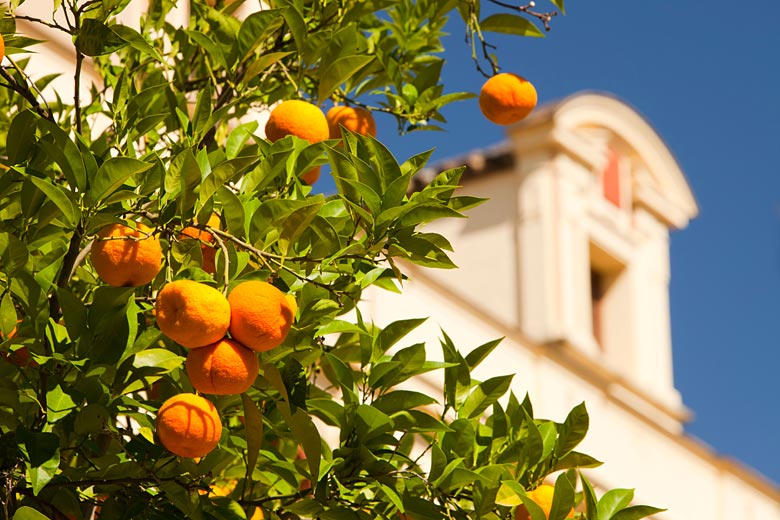
Introduced by the Moors in the 10th century, orange trees still dot the city. Seville's orange season typically runs from December to mid-February, while noses will twitch at the warming, sweet scent of orange blossom, which fills the air from late February to March.
7. It's home to one of Spain's greatest sporting rivalries
While the most famous league game in Spain (and probably the world) is undoubtedly El Clasico (Real Madrid versus Barcelona), the most fiercely-fought derby is widely regarded to be El Gran Derbi, played between Seville's two top football teams, Sevilla FC and Real Betis.
Sevilla FC is Spain's oldest football club and, marginally, the more successful of the two. Both teams play in somewhat ageing stadiums but the atmospheres are superb, especially as each team has its own anthem, which is sung heartily by fans at the beginning and end of matches.
Tickets for both teams can be bought online a few weeks before matches but you'll be lucky to secure tickets for El Gran Derbi. Still, if you're visiting when this game takes place, you'll know about it!
If going to a game, try to get there a little early to sample the atmosphere in the bars surrounding the stadium and pick up a bocadillo (sandwich) to eat at halftime if you really want to fit in with the locals.
8. It has its own secret motto
The eagle-eyed will spot the mysterious code of NO8DO found on everything from the city's municipal flag to manhole covers.
This secretive city motto is said to have come from King Alfonso X who, in the 13th century, battled his son Sancho for the throne.
As the people of Seville remained loyal to Alfonso during the struggle, after his victory he bestowed this cryptic sign, which is believed to mean "She Seville has not abandoned me", upon the city as an acknowledgement of the people's support. See how many you can spot.
9. You can climb enormous mushrooms
In a bid to transform a local area within the old town of Seville, the council ran a competition to design something new, fresh and truly 21st-century. The winner was a German architect called Jürgen Mayer and, in 2005, work began on his mega construction.
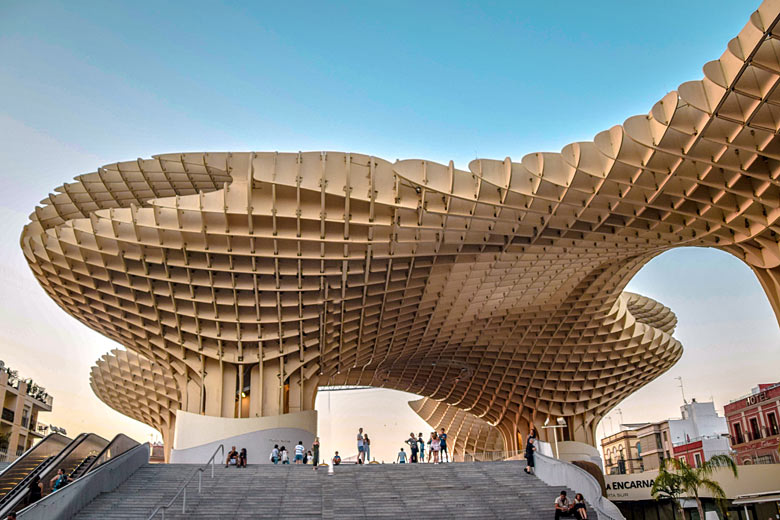
Opened in 2011, the name soon evolved from the more formal Metropol Parasol to Las Setas, or the mushrooms, owing to the fungi-shaped curves of this behemoth.
The mushrooms, which claim to be the largest wooden structure in the world, are made up of six 'parasols' over five floors, reaching a top height of around 26 metres (85 ft).
As well as the viewing platform, you'll find the Antiquarium museum in the basement where Roman and Moorish remains were discovered during the build, markets, a public plaza and a sky-high restaurant.
10. Shop in the HQ of the Spanish Inquisition
Step inside the Mercado de Triana and among the great piles of 'bull's egg' tomatoes, counters of queso (cheese) and bars serving cold cañas (small beers), you'll be walking in the footsteps of some of Spain's most notorious inquisitors.
For this lively market in the Triana neighbourhood is located above the remains of the Castillo de San Jorge. Although built by Moors in the 12th century, by 1481, the castle had become the seat of power for the Catholics pursuing the Spanish Inquisition.
For an insight into this dark period, be sure to visit the Inquisition Museum among the ruins beneath the market.
Please note: the museum is currently listed as temporarily closed, so check before visiting.
11. Visit a monastery-turned-porcelain-factory-turned-gallery
Escape the city on a trip to the Centro Andaluz de Arte Contemporáneo (CAAC), or the Andalusian Center for Contemporary Art. Located on an island in the river, this national monument is a hub of modern art, hosting exhibitions, workshops and events.
Originally a monastery, it was founded in the 15th century and remained a religious institute until it was claimed by the Spanish government during 'la desamortización', the confiscation of monastic properties by the state between 1835 and 1837, and sold to an Englishman, Charles Pickman.
Pickman subsequently turned the monastery into a porcelain factory, which churned out accolade-winning ceramics from 1841 until its closure in 1984. The CAAC moved into the multi-purpose space in 1997.
Today, you can wander freely around the church, chapels, cloisters and the huge bottle-shaped kilns while admiring contemporary creations, sculptures, photographs and paintings. Don't miss the garden café, a popular spot for equally creative, good value tapas in the sunshine.
12. It's championing the e-scooter
In June 2021, an 18-month trial of easy-to-hire e-scooters kicked off in the city. Around 2,000 e-scooters can be found throughout Seville, which can be rented via mobile apps from two companies, Reby and Voi.
Love them or hate them, e-scooters offer a fun and fast way to zip around Seville and their presence in the cycle lanes shows that they're undeniably popular.
In a bid to keep everyone happy, when entering a pedestrianised area or somewhere that you are not supposed to scoot, these smart e-scooters automatically slow down or even cut out and require a push until you reach a scooter-friendly zone once again.
13. There's a tower within a tower
Although part of the cathedral, the Giralda is deserving of a point all of its own. Originally the minaret for the 12th-century mosque, the magnificent bell tower is, in fact, made of two towers: an inner one wrapped inside an outer one.
The space between the two towers is spiralled with 35 ramps, which the Alhomad sultan used to ride his horse to the top. Unfortunately, you will need to use your feet to reach the peak just below 100 meters (328 ft) up, but the views across the city are worth it.
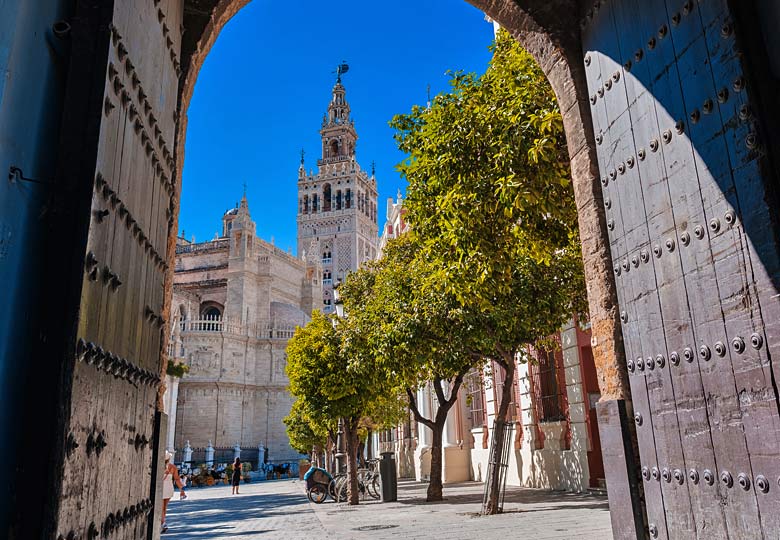
The Giralda is another exquisite example of Islamic and Christian architecture in one. It evolved over the centuries with additions such as Christian symbols, Renaissance touches and the bells in the 16th century. It is a masterpiece of craftsmanship and is said to have influenced the design of towers not only across Spain but the New World too.
14. It's close to the remains of a Roman city
Around 9 km north of Seville, you'll find the expansive and well-preserved ruins of the Roman city of Itálica, which was founded in 206 BCE.
The site, which covers some 52 hectares, has plenty to see from mosaics depicting birds and people to the remains of houses, temples, baths, a theatre, an impressive amphitheatre and an aqueduct. Many of the finds from the site can also be seen at the Seville Archaeological Museum.
15. You can dine in an ancient bathhouse
In 2020, the owners of Cervercería Giralda, which has been a lively watering hole since 1923, put downtime caused by the pandemic to good use by renovating their bar.
While knocking through plaster, a vaulted ceiling with an eight-point star-shaped skylight emerged and an archaeologist was called in. Further digging revealed a 12th-century hammam or bathhouse with geometric designs as well as the skylight. Pop in for a drink or some tapas to admire this fabulous find from within.
16. The weather is fabulous all year round
However you like your weather on holiday, there's a month for you in Seville. Hot in summer, warm in spring and autumn, cooler in winter, there's always sunshine to be had and little rainfall.
| Jan | Feb | Mar | Apr | May | Jun | Jul | Aug | Sep | Oct | Nov | Dec | |
|---|---|---|---|---|---|---|---|---|---|---|---|---|
| Maximum daytime temperature °C | ||||||||||||
| Hours of sunshine (daily) | ||||||||||||
| Days with some rainfall |
Find out more about the climate in Seville.
Ready to discover Seville's secrets? Check out the latest online deals and discounts from First Choice on holidays, hotels and more.
More about the Costa de la Luz
- Overview
- Best time to visit
- Weather by month
- 5-day weather forecast
- Destinations
- Travel advice
- Deals & discounts
Costa de la Luz by month
Jan Feb Mar Apr May Jun Jul Aug Sep Oct Nov Dec
Explore holidays in the sun for less
- Beach holidays
- Family holidays
- City breaks
- Summer holidays
- Winter sun holidays
- Holiday offers
- Top travel brands
- Airlines & flights
- Discount hotels
- Airport parking deals
- TUI
- Jet2holidays
- easyJet holidays
- Love Holidays
- Black Friday sales
Airport parking
- Manchester Airport
- Stansted Airport
- Bristol Airport
- Luton Airport
- Birmingham Airport
- Edinburgh Airport
- Gatwick Airport
- Glasgow Airport
- Newcastle Airport
Airport lounges
- Manchester Airport
- Birmingham Airport
- Bristol Airport
- Edinburgh Airport
- Glasgow Airport
- Heathrow Airport
- Newcastle Airport
- Stansted Airport
- Gatwick Airport
Be inspired
Get your weekly fix of holiday inspiration from some of the world's best travel writers plus save on your next trip with the latest exclusive offers
We promise not to share your details





























